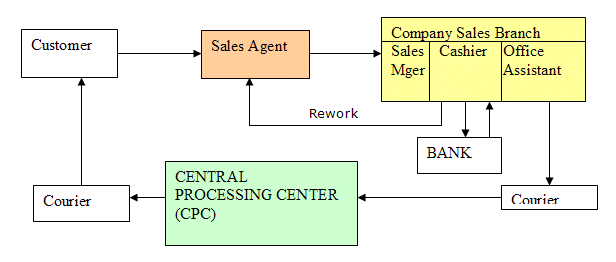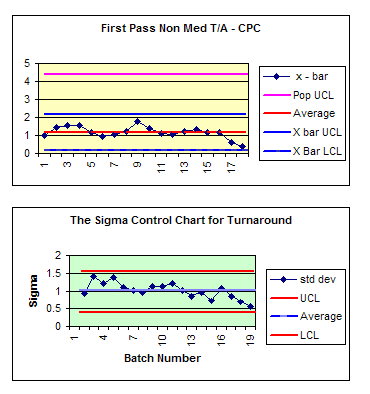
The work described in this case study was undertaken in a young, rapidly expanding company in the financial services sector with no previous experience with total quality management (TQM). The quality project began with a two-day introductory awareness program covering concepts, cases, implementation strategies and imperatives of TQM. The program was conducted for the senior management team of the company. This program used interactive exercises and real life case studies to explain the concepts of TQM and to interest them in committing resources for a demonstration project. The demonstration project, which used the seven steps of problem solving (similar to DMAIC [Define, Measure, Analyze, Improve, Control]), was to show them how TQM concepts worked in practice before they committed resources for a company-wide program.
Main Components of TQM
For Six Sigma practitioners who may not be familiar with TQM, the program has three main components – just in time (JIT), total quality control (TQC) and total employee involvement (TEI).
The relationship among the three legs of TQM is: JIT exposes the cause of problems; TQC helps provide a solution to problems. Lastly, since the employees do all improvements; they need to be involved in the process of change. TEI helps elicits this involvement.
JIT uses techniques similar to Lean, and TQC uses tools and techniques similar to Six Sigma tools.
Step 1. Define the Problem
1.1) Selecting the theme: A meeting of the senior management of the company was held. Brainstorming produced a list of more than 20 problems. The list was prioritized using the weighted average table, followed by a structured discussion to arrive at a consensus on the two most important themes – customer service and sales productivity.
The customer service theme, “reducing the turnaround time from an insurance proposal to policy,” was selected as the most obvious and urgent problem. The company was young, and therefore had few claims to process so far. The proposal-to-policy process therefore impacted the greatest number of customers.
An appropriate cross functional group was set up to tackle this problem.
1.2) Problem = customer desire – current status:
Current status: What did the individual group members think the turnaround is currently? As each member began thinking questions came up. “What type of policies do we address?” Medical policies or non-medical? The latter are take longer because of the medical examination of the client required. “Between what stages do we consider turnaround?” Perceptions varied, with each person thinking about the turnaround within their department. The key process stages were mapped:

Several sales branches in different parts of the country sent proposals into the central processing center (CPC). After considerable debate it was agreed at first to consider turnaround between entry into the computer system at the company sales branch and dispatch to the customer from the CPC. Later the entire cycle could be included. The perception of the length of turnaround by different members of the team was recorded. It averaged:
Non-medical policies 17 days
Medical policies 35 days
Invoking the slogan from the awareness program “In God we trust, the rest of us bring data,” the group was asked to collect data and establish reality. Armed with a suitably designed check sheet they set about the task.
Customer desire: What was the turnaround desired by the customer? Since a customer survey was not available, individual group members were asked to think as customers – imagine they had just given a completed proposal form to a sales agent. When would they expect the policy in hand? From the customer’s point of view they realized that they did not differentiate between medical and non-medical policies. Their perception averaged out six days for the required turnaround.
“Is this the average time or maximum time that you expect?” they were asked. “Maximum,” they responded. It was clear therefore that the average must be less than six days. The importance of “variability” had struck home. The concept of sigma was explained and was rapidly internalized. For 99.7 percent delivery within the customer limit the metric was defined.
Customer desire:
Average+3 sigma turnaround = less than 6 days
Current status:
Non-medical policies (average 19/sigma 15) average+3 sigma= 64 days
Medical (average 37/sigma 27) average+3 sigma= 118 days
The Problem was therefore defined:
Reduce Average+3 sigma of turnaround for:
Non-medical policies from 64 to 6 days
Medical policies from 118 to 6 days
The performance requirement appeared daunting. Therefore the initial target taken in the mission sheet (project charter) was to reduce the turnaround by 50 percent – to 32 and 59 days respectively.
Step 2. Analysis of the Problem
In a session the factors causing large turnaround times from the principles of JIT were explained. These were:
- Input arrival patterns
- Waiting times in process
– Batching of work
– Imbalanced processing line
– Too many handovers
– Non-value added activities, etc. - Processing times
- Scheduling
- Transport times
- Deployment of manpower
Typically it was found that waiting times constitute the bulk of processing turnaround times. Process mapping (value stream mapping in Lean) was undertaken. The aggregate results are summarized below:
Number of operations 84
Number of handovers 13
In-house processing time (estimated) 126 man-minutes
Range of individual stage time 2 to 13 minutes
Could this be true? Could the turnaround be 126 minutes for internal processing without waiting? The group started to question of the status quo. The change process had begun. To check this estimate it was decided to collect data – run two policies without waiting and record the time at each stage. The trial results amazed everyone: Policy No. 1 took 100 minutes and Policy No. 2 took 97 minutes. Almost instantly the mindset changed from doubt to desire: “Why can’t we process every proposal in this way?”
Step 3. Generating Ideas
In the introductory program of TQM during the JIT session the advantages of flow versus batch processing had been dramatically demonstrated using a simple exercise. Using that background a balanced flow line was designed as follows:
1. Determine the station with the maximum time cycle which cannot be split up by reallocation – 8 minutes.
2. Balance the line to make the time taken at each stage equal 8 minutes as far as possible.
3. Reduce the stages and handovers – 13 to 8.
4. Eliminate non-value added activities – transport – make personnel sit next to each other.
5. Agree processing to be done in batch of one proposal.
Changing the mindset of the employees so they will accept and welcome change is critical to building a self-sustaining culture of improvement. In this case, the line personnel were involved in a quality-mindset program so that they understood the reasons for change and the concepts behind them and are keen to experiment with new methods of working. The line was ready for a test run.
Step 4. Testing the Idea
Testing in stages is a critical stage. It allows modification of ideas based upon practical experience and equally importantly ensures acceptance of the new methods gradually by the operating personnel.
Stage 1: Run five proposals flowing through the system and confirm results. The test produced the following results:
Average turnaround time: < 1 day
In-house processing time: 76 mins.
There was jubilation in the team. The productivity had increased by 24 percent. The head of the CPC summarized: “I gave five files for processing, and went for a meeting. Emerging from the meeting about 30 minutes later I was greeted by the dispatch clerk jubilantly reporting, “‘Madam, the TQM files are ready for dispatch.'” The mindset was dramatically changed and line personnel were now keen to push the implementation.
Stage 2: It was agreed to run the new system for five days – and compute the average and sigma of the turnaround to measure the improvement. It was agreed that only in-house processing was covered at this stage and that the test would involve all policies at the CPC but only one branch as a model. This model, once proved, could be replicated at other branches.
The test results showed a significant reduction in turnaround:
1. For all non-medical policies: from 64 to 42 days (or 34 percent)
2. For policies of the model branch: from 64 to 27 days (or 60 percent)
The mission sheet goal of 50 percent reduction had been bettered for the combined model branch and CPC. Further analysis of the data revealed other measures which could reduce the turnaround further. Overall reduction reached an amazing 75 percent. Turnaround, which had been pegged at 64 days, was now happening at 99.7 percent on-time delivery in 15 days.
Step 5. Implementing the Ideas
Regular operations with the new system was planned to commence. However, two weeks later it was still not implemented. One of the personnel on the line in CPC had been released by his department for the five-day trial to sit on the line but was not released on a regular basis. The departmental head had not attended the TQM awareness program and therefore did not understand why this change was required.
There were two options – mandate the change or change the mindset to accept the change. Since the latter option produces a robust implementation that will not break down under pressures it was agreed that the group would summarize TQM, the journey and the results obtained in the project so far and also simulate the process with a simple exercise in front of the department head. This session was highly successful and led to the release of the person concerned on a regular basis.
Step 6. Check the Result
The process was run for one month with regular checks. The results obtained were marginally better than the trials conducted in Step 5:
Average 11 days
Sigma 9 days
Average+3 sigma 38 days
Step 7. Standardize Control/Document the Improvement Story
- Essentially the in-house processes in two centers of processing – the CPC and one sales branch – had been impacted so far. To make sure that the gains were held, control charts were introduced in both locations. Sample x-bar and sigma-control charts for the CPC are shown below:

- A special grind it-in session was conducted for line personnel to ensure that the control chart was updated every day, and any deterioration was dealt with by finding and killing the root causes of the problems.
- Customer reaction: Sales management and sales agents (internal customers) clearly noticed the difference. For instance one sales manager reported that a customer had received a policy within a week of giving a proposal and was so amazed that he said, “If you give such service I will give you the next policy also!”
- Adoption of a similar process at the CPC and the model branch for medical policies has already reduced the average+3 sigma of turnaround time by 70 percent – from 118 days to 37 days. The corresponding all-India reduction was from 118 days to 71 days – a 60 percent reduction.
- The project objective of 50 percent in the first stage has been achieved.
- A quality improvement story was compiled by the project leader for training and motivating all employees.
Future Actions
Non-medical policies: Goal to reduce turnaround from 42 days to about 15 days.
1. Roll out process to branches to achieve 24 days throughout the country.
2. Minimize rework by analyzing, prioritizing and training sales branches to avoid the causes of rework.
3. Working with the bank to improve the turnaround time of banking checks.
4. Considering processing proposals while check clearance is in progress.
Medical policies: Goal to reduce turnaround from 71 days to about 24 days.
1. Roll out process to branches to reduce turnaround from 71 to 37 days.
2. Streamline the process of medical exam of the client from 37 to 24 days.